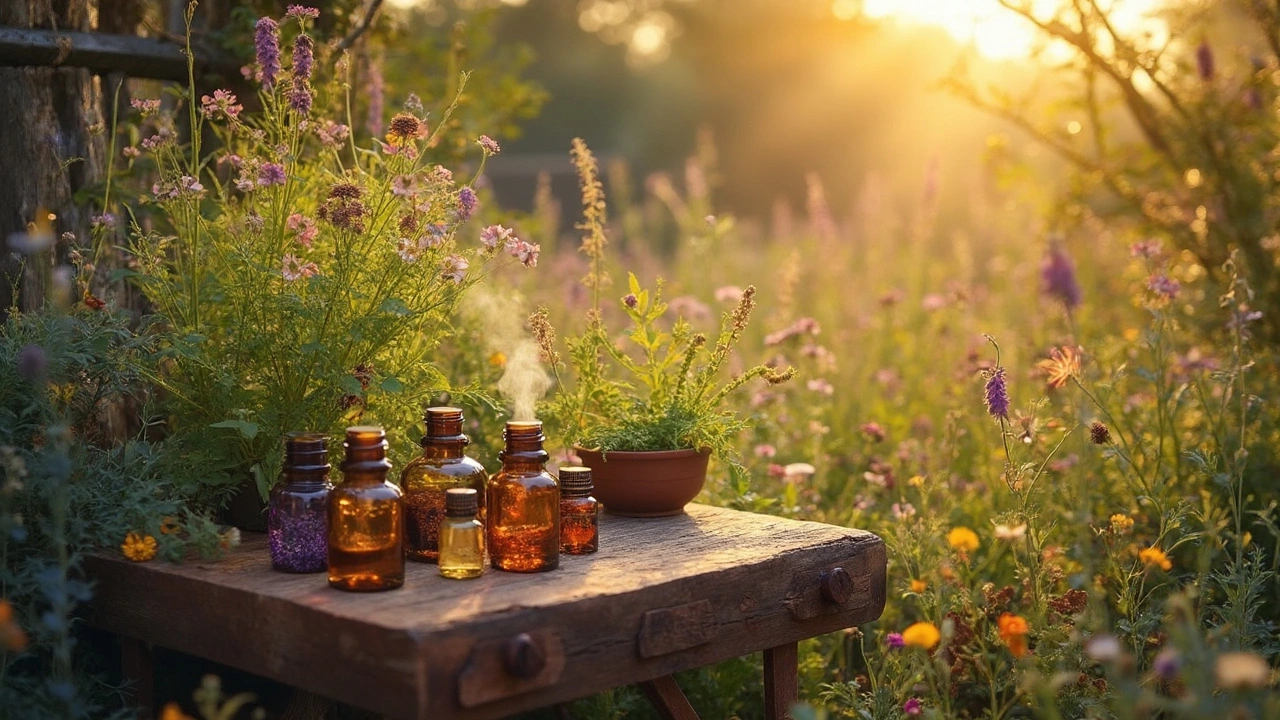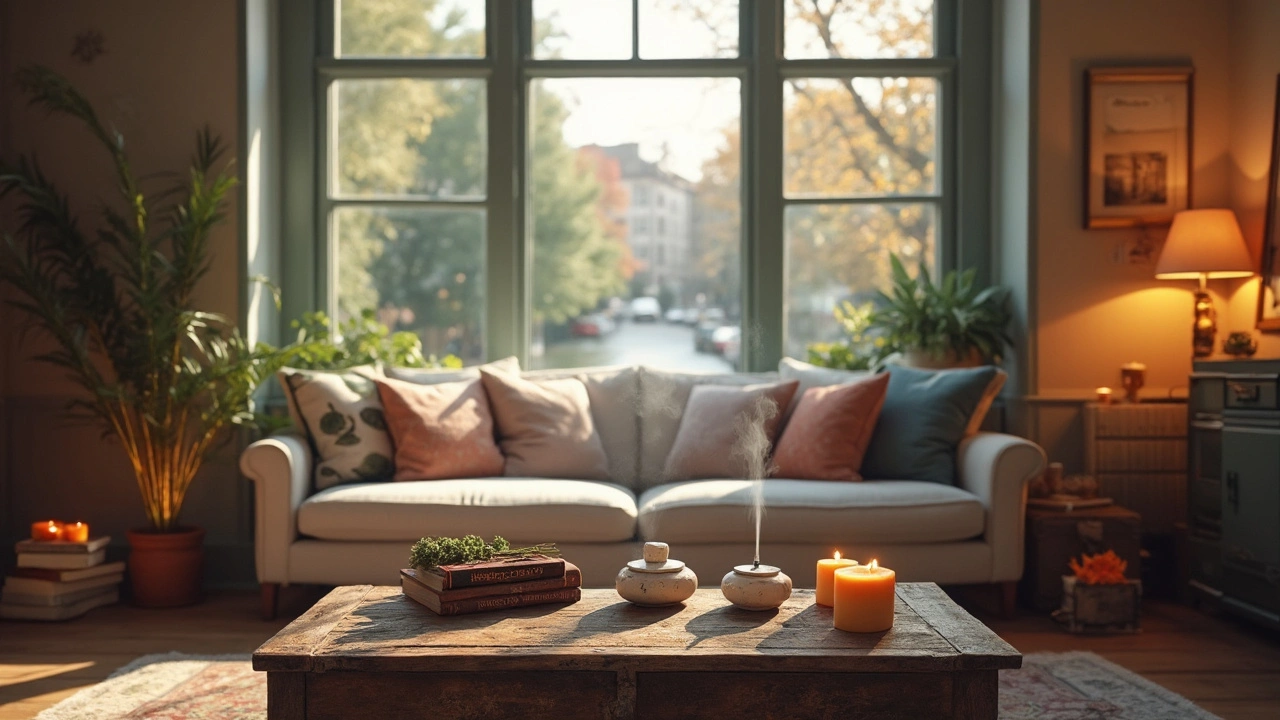Aromatherapy—ever thought about why a whiff of lavender can instantly help you chill out? It's not magic, but once you get the hang of it, it sure feels like it. Aromatherapy is basically the practice of using essential oils, which are concentrated plant extracts, to improve your mood or health. Sounds simple, right? But there's definitely more to learn!
Imagine standing in a forest and taking a deep breath. The earthy smells that fill the air can do wonders for clearing your mind. Similarly, essential oils capture those scents, and when used right, they can really enhance your day-to-day life. Ready to uncover how these little bottles of goodness work?
- What is Aromatherapy?
- How Essential Oils Work
- Choosing the Right Essential Oils
- Practical Tips for Using Aromatherapy
- Interesting Facts About Aromatherapy
What is Aromatherapy?
So, what exactly is this thing called aromatherapy? It's like using nature’s own toolkit for health and happiness. In a nutshell, it involves using essential oils to help your body and mind unwind or even rev up, depending on what you need. Essential oils are the tiny, powerful liquids that come from plants. Think of them as super-concentrated plant essences packed in little bottles.
How do they make you feel better, you ask? Well, when you inhale those relaxing or invigorating scents, they interact with the limbic system in your brain—the area that deals with emotions and memories. That’s why the smell of lemon can boost your mood or lavender can help you calm down. It's fascinating how the right scent can swap your anxiety with a sense of peace or turn your fatigue into focus.
The Components Behind the Magic
Each oil contains a unique mix of natural chemicals, which have specific effects. For instance, lavender is packed with linalool and linalyl acetate, which are known for their calming properties. Meanwhile, peppermint oil, filled with menthol, is often used for its refreshing and energizing effects.
Global Reach and Historical Roots
Aromatherapy isn't something brand new or a fleeting trend. It's been around for centuries. Ancient Egyptians and Chinese cultures were using aromatic oils for pretty much everything from religious rituals to medical treatments. Fast forward to today, you’ll find aromatherapy practices all around the globe—people from all walks using them for wellness and relaxation.
Whether you're skeptical about it or already love aromatic cures, it has gained a fair bit of attention. Studies showing benefits like stress reduction or improved sleep are bringing more fans into this fragrant field.
How Essential Oils Work
So, let's break it down. Essential oils are like the secret essence of plants. They're extracted from flowers, leaves, roots, or other parts of a plant. This isn't a new fad—it’s actually been around for centuries!
Going through the Nose
When you take a sniff, the aroma molecules travel through the nose and get cozy with scent receptors that play a role in your brain's limbic system. This area handles emotions, which is why a pleasant smell can change how you feel in just moments.
Absorption through the Skin
What about if you apply them to your skin? Well, these oils get absorbed and pass into your bloodstream. It's pretty cool! Just remember, a little goes a long way, and it's usually a good idea to mix these with a carrier oil like coconut or jojoba to make sure your skin stays happy.
Active Compounds
Each type of oil has a different set of compounds. Like, lavender has linalool, which is known for its chill vibes. Meanwhile, peppermint contains menthol, which can get you feeling fresh and focused. These compounds work with your body's natural systems, influencing things like mood, energy levels, and even digestion.
Effective Use
Using them isn’t rocket science, but there are ways to get it right. Some folks use aromatherapy diffusers to spread the scent through a space. Want to try a bath? Add a few drops to a warm tub for a relaxing soak. Just keep the ratio safe—usually a few drops are all you need.
If numbers interest you, check this out:
| Oil | Main Compound | Common Use |
|---|---|---|
| Lavender | Linalool | Relaxation, Sleep |
| Peppermint | Menthol | Energy, Focus |
Pretty straightforward, right? With a bit of know-how, you can make essential oils work for you in ways that are surprisingly effective and, more importantly, really enjoyable.

Choosing the Right Essential Oils
Picking the right essential oils can feel like trying to choose the perfect ice cream flavor—there are so many options! But no worries, I'll help you through it. Let's start by figuring out what you're using them for. Each oil has its own personality and benefits.
Consider Your Purpose
First things first, what do you need it for? Are you looking to relax, boost your mood, or maybe ease some physical pain? Here's a quick guide:
- Lavender: Perfect for relaxation and sleep. It's like a warm hug in a bottle.
- Peppermint: Great for headaches and boosting mental clarity. Imagine a fresh breeze blowing the cobwebs away.
- Lemon: Uplifting and energizing. If your mood needs a little sunshine, this is your go-to.
- Eucalyptus: Excellent for respiratory issues. Think of it as your own mini sauna detox.
Quality Over Quantity
It’s essential to pick good quality oils. You want them 100% pure, not diluted with anything else. Look for reputable brands. Check labels for the plant's Latin name and extraction method. Cold-pressed or steam distilled processes maintain the oil’s integrity.
Test Before You Commit
Always try a patch test. Some oils might irritate your skin. Dilute a drop with a carrier oil like coconut or jojoba, apply it to a small skin area, and wait 24 hours. No reaction? You're good to go! Repeat this with new oils to ensure you’re playing it safe.
To sum it up, choosing essential oils is about what vibes with your needs. Trust your senses, do a little research, and soon you’ll have your own handy collection for whatever life throws your way.
Practical Tips for Using Aromatherapy
So you're ready to dive deeper into the world of aromatherapy. Awesome choice! Whether you're using it to chill out after a long day or to boost your mood, here are some practical tips to get you started.
Start with the Basics: Choosing Essential Oils
The first step is picking the right essential oils. If you're after relaxation, oils like lavender and chamomile are popular choices. Feeling a bit sluggish? Then maybe you'd like to try peppermint or lemon, which can be quite energizing.
For a beginner, it might help to stick with just a few oils that serve different functions, gradually working up your collection as you learn. Also, make sure to buy 100% pure oils. You don't want any synthetic additives messing with the natural benefits.
Use Them Safely: Dilution and Applications
It's crucial to remember that these oils are potent. You should always dilute them with a carrier oil like jojoba or coconut before applying them to your skin. Typically, a safe rule of thumb is 3-5 drops of essential oil per teaspoon of carrier oil.
Looking to fill the room with scent? Try using a diffuser. It'll spread the aroma around without overwhelming your senses. Just follow the instructions on your diffuser for the best results.
Explore Different Methods: Not Just for Diffusers
Aromatherapy isn't just about diffusers. Try adding a few drops to your bath for an immersive experience. Another idea is to make a DIY spray by mixing essential oils with water in a spray bottle. You can use this as a refreshing room or linen spray.
If you're on the go, consider a personal inhaler. These are pocket-sized and handy for a quick pick-me-up anytime, anywhere.
Finally, keep in mind the shelf life of your oils. Most will last about a year, but citrus oils might lose their potency a bit quicker.
Mix and Match: Creating Your Blends
Once you feel comfortable, begin experimenting by mixing oils to create your own unique scents. A classic combo is lavender and peppermint for relaxation with a hint of alertness.
To help track your favorite blends or new ones to try, keep a journal. This way, when you find that perfect combo, you won't forget it next time.
With these tips in mind, you'll be a wellness guru in no time, all thanks to the wondrous world of aromatherapy!

Interesting Facts About Aromatherapy
Let’s dive into some cool and lesser-known tidbits about aromatherapy. Trust me, it’s more intriguing than it might seem at first sniff!
Diverse Range of Essential Oils
First off, did you know there are over 90 types of essential oils commonly used in aromatherapy? From lavender to peppermint, each one has its own unique properties and benefits. So, if you thought aromatherapy was just lavender and eucalyptus, there's a whole scent universe waiting for you!
Ancient Roots: Not Just a Modern Trend
Aromatherapy might feel like a trendy wellness practice, but it's actually been around for ages. We’re talking ancient Egypt and China. These civilizations used plant-based scents for things like healing and religious rituals. So, using aromas to boost our wellbeing is an age-old tradition.
Scents and Memory: A Strong Connection
Ever caught a whiff of something and it's taken you back to a childhood memory? That’s because the olfactory system is super linked with memory areas in your brain. Using specific oils can trigger both emotions and memories, making aromatherapy a powerful tool for mental health and wellness.
Science Backed Benefits
It's not just all in your head, literally! Studies have shown that certain essential oils have concrete health benefits. For example, lavender is famous for reducing stress and anxiety. On the other hand, peppermint is often used to improve focus and energy levels.
Statistics and Preferences
Ever wonder how popular aromatherapy actually is? Here's a quick look at some stats from a 2024 wellness survey:
| Essential Oil | Most Popular Use |
|---|---|
| Lavender | Stress Relief |
| Peppermint | Improved Focus |
| Lemon | Energy Boost |
At the end of the day, aromatherapy is about finding what works for you. Whether it's combating stress or just wanting your room to smell amazing, there’s likely an oil for that!
